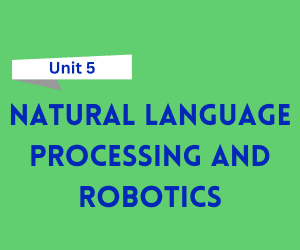
Free Download Natural Language Processing and Robotics Notes in pdf – Bca 6th Semester. High quality, well-structured and Standard Notes that are easy to remember.
Click on the Download Button 👇
Natural Language Processing (NLP) and Robotics
Natural Language Processing (NLP) is a field of artificial intelligence focused on the interaction between computers and human (natural) languages. It enables machines to understand, interpret, and generate human language. Robotics involves the design, construction, operation, and use of robots, which are automated machines that can carry out tasks typically performed by humans.
Key Points about NLP
Definition:
- NLP: A technology that allows computers to process and understand human language in text or speech form.
Components of NLP:
- Syntax: Structure of sentences and phrases.
- Semantics: Meaning of words and sentences.
- Pragmatics: Context in which language is used.
- Discourse: Coherence of the text across sentences.
Applications of NLP:
- Speech recognition (e.g., virtual assistants like Siri or Alexa).
- Machine translation (e.g., Google Translate).
- Text analysis (e.g., sentiment analysis).
- Chatbots and conversational agents.
- Information retrieval (e.g., search engines).
Key Points about Robotics
Definition:
- Robotics: A field that involves designing and building robots capable of performing tasks autonomously or semi-autonomously.
Types of Robots:
- Industrial Robots: Used in manufacturing (e.g., assembly lines).
- Service Robots: Assist with tasks like cleaning, healthcare, or entertainment.
- Autonomous Robots: Operate independently in environments like space or underwater.
- Humanoid Robots: Designed to resemble humans in both appearance and functionality.
Applications of Robotics:
- Manufacturing (e.g., assembly lines).
- Healthcare (e.g., surgery assistance, elder care).
- Exploration (e.g., Mars rovers).
- Autonomous vehicles (e.g., self-driving cars).
Features of NLP
- Text and Speech Processing: NLP can process both written text and spoken language, converting them into machine-readable formats.
- Machine Translation: Enables translation between languages automatically.
- Context Understanding: NLP systems are capable of understanding the context in which words or phrases are used.
- Text Summarization: Extracts key points from long documents.
- Speech Recognition: Transforms spoken language into text, facilitating voice-driven applications.
- Sentiment Analysis: Analyzes opinions or emotions in a piece of text.
Features of Robotics
- Autonomous Operation: Robots can perform tasks without human intervention, using sensors and AI.
- Precision and Efficiency: Robots can perform repetitive tasks with high accuracy.
- Adaptability: Robots can adapt to different environments or tasks through programming and machine learning.
- Human-Robot Interaction: Robots can interact with humans through natural interfaces, such as voice or gestures.
- Real-Time Decision-Making: Robots process inputs from sensors and make decisions quickly to perform tasks.
FAQs on Natural Language Processing (NLP)
Q1: How does NLP work?
NLP works by using algorithms to analyze language data, including syntax, semantics, and context, to extract meaningful information, translate languages, or generate human-like text.
Q2: What are the challenges in NLP?
- Ambiguity: Words can have multiple meanings depending on context.
- Context understanding: Interpreting context in language can be difficult.
- Complex language structures: Languages have diverse rules that are hard for machines to comprehend.
Q3: What are common applications of NLP?
- Speech recognition (e.g., Siri, Alexa).
- Sentiment analysis for market research.
- Chatbots and conversational AI.
- Machine translation (e.g., Google Translate).
Q4: What tools are used for NLP?
- Libraries like NLTK, spaCy, and Hugging Face’s Transformers.
- Pre-trained models like BERT and GPT for text generation and understanding.
FAQs on Robotics
Q1: What is the difference between industrial robots and service robots?
- Industrial robots are designed for repetitive tasks in manufacturing settings.
- Service robots are used for tasks that require interaction with humans or the environment, such as medical assistance or cleaning.
Q2: How do robots “see” and understand the environment?
Robots use sensors like cameras, LiDAR, and infrared sensors to collect data from their surroundings, which is then processed by AI to understand the environment and make decisions.
Q3: What is autonomous robotics?
Autonomous robots can operate without direct human control by using sensors, cameras, and AI to make decisions based on real-time data.
Q4: How are robots programmed?
Robots are programmed using specialized languages like Python, C++, and Robot Operating System (ROS) to control their movement, perception, and interaction with the environment.
Q5: What are the ethical concerns regarding robotics?
Ethical concerns include job displacement, safety, privacy, and the potential for robots to be used in harmful ways (e.g., military robots).